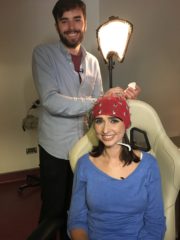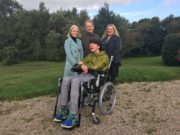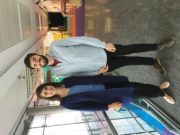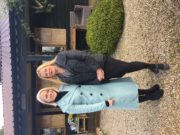10 THINGS TO KNOW ABOUT… (SERIES 3)
Monday 13 November 2017, 8.30pm on RTE One
Episode 2 – BrainTech – TX Monday 20th November
Can the mind connect directly with computers to communicate thought and transcend human
limitation? What makes one part of a day more memorable than another? Alan Smeaton, Director of INSIGHT Centre for Data Analytics, is using EEG technology to measure levels of electrical activity in the brain to better understand how it relates to the person’s attention level, and potentially provide insight into human memory encoding and processing. Ever the willing guinea pig, Jonathan wears a portable EEG headset and camera for a day to find out how his memories of that day relate to peaks and troughs in his overall brain activity. It’s still early days, but if we can better understand the memory encoding process, then this type of basic research could have future applications for understanding and improving learning and memory-related health conditions.
The “cocktail party effect” is the ability of the human brain to listen to one conversation in a noisy environment and filter out other conversations. Computers can’t do this, so why is that? In search of answers, IRC-funded Michael Broderick, TCD asks Aoibhinn to don an EEG cap and listens to two audiobooks, one in each ear, while Michael records and analyses her brain signals. By trying to identify which book she’s listening to from her brain activity, Michael explains how this research could be used to develop ‘smart’ hearing aids that would identify what conversation the wearer is listening to, and in real time boost the audio signal for that conversation while filtering out extraneous sound.
In Weird Science, Fergus reveals how themes of the futuristic Avatar film and being applied to BCI to give us brain controlled turtles! (disclaimer: no animals were harmed in the process!)
Pierre Jolivet is a perception and sound artist and technician who is incorporating biofeedback into electronic music composition – essentially, creating music with his mind! Blending science and art, this creative technology could enable people with physical disabilities to compose music and sounds in the same way as an able-bodied person plays an instrument. Kathriona plugs in her mind to discover how BCI technology can be about enriching lives as well as assisting. World-renowned neurologist Adrian Owen is using fMRI and EEG technology to enable vegetative state patients to communicate with their carers and/or family members. By analysing their brain activity he’s found a way to calibrate how they elicit simple yes/no answers to questions. Jonathan finds out more about the incredible breakthrough that could literally transform peoples’ lives.
BCI technology is a great way to combine science with arts and creativity to enhance lives. Kathriona meets SMARTLab’s Prof Lizbeth Goodman, to discuss opportunities for assistive technology for people with disabilities, and meets Paddy Schaler, who, having survived a severe Acquired Brain Injury in 2012, is working with SMARTLab to develop technology that includes being able to fly a drone with his mind!
Series overview
Revealing secrets of the earth and stars, and blurring lines between minds and machines, Irish scientists have their fingers on the pulse! Aoibhinn, Jonathan and Kathriona are back and checking out all the latest incredible developments in Irish research. This year we will see them up in the skies and deep underground, across Ireland and Europe, investigating the projects that will impact on all our lives.
Highlights include: the alarming rise of Superbugs; the race to recreate the awesome power of the sun; Gene therapies that could provide the answer to some devastating conditions such as blindness; Secrets under the earth’s surface that threaten but also sustain our way of living; mind controlled technology and lifesaving drones.
Perennial favourite, Dr Fergus McAuliffe, returns with his weekly Weird Science segment showcasing some of the more bizarre aspects of current research – from hipster beards that harbour new antibiotics, to brain controlled turtles and Jurassic park-style Mammoths!
SERIES SUPPORTED BY EPA, HEA, Irish Research Council, RTÉ, SEAI and Teagasc.
For more information please contact info@newdecade.ie
or visit www.10thingstoknowabout.ie








